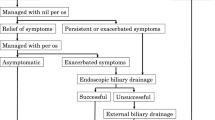Abstract
Pancreatic drainage patterns have been studied by endoscopic retrograde cholangiopancreatography (ERCP) in four children with choledochal cyst (CC). The first two had mild or chemical pancreatitis; the third had a history of recurrent cholangitis and was diagnosed as chronic pancreatitis. The fourth manifested with severe, acute pancreatitis. All children were found to have an impaired flow through the papilla of Vater. In the first three cases, the duct of Santorini (DS) seemed to play an important role in the pancreatic drainage. In the fourth case, however, the duct was found to be absent. ERCP findings in additional eleven children without CC also were reviewed, and in this group the DS did not seem to play any significant role in pancreatic drainage. These results indicate that in children with common bile duct (CBD) anomalies, the DS may relieve the obstruction and ameliorate the pancreatitis.
Similar content being viewed by others
References
Bluestein PK, Gaskin K, Filler R, Chai-Sing H, Connon J (1981) Endoscopic retrograde chlangiopancreatography in pancreatitis in children and adolescent. Pediatrics 68: 387
Cotton PB, Laage NJ (1982) Endoscopic retrograde cholangiopancreatography in children. Arch Dis Child 57: 131
Forbes A, Leung JWC, Cotton PB (1984) Relapsing acute and chronic pancreatitis. Arch Dis Child 59: 927
Allendorf M, Werlin SL, Geenen JE et al. (1987) Endoscopic retrograde cholangiopancreatography in children. J Pediatr 110: 206
Weizman Z, Durie PR (1988) Acute pancreatitis in childhood. J Pediatr 113: 24
Dawson W, Langman J (1961) An anatomical — rediological study on the pancreatic duct pattern in man. Anat Rec 139: 59
Berman LG, Prior JT, Abramow SM, Ziegler (1960) A study of the pancreatic duct system in man by the use of vinil acetate casts of postmortem preparations. Surg Gyn Obstet 110: 391
Lacy PE, Kissane JM (1977) Pancreas and diabetes mellitus. In: Anderson WAD, Kissane JM (eds) Pathology, 7th edh. CV Mosby, St Louis, p 1457
Ansel HJ (1977) Normal pancreatic duct. In: Stewart ET, Vennes JA, Geenen JE (eds), Atlas of endoscopic retrograde cholangiopancreatography. CV Mosby, St Louis, p 43
Volk B (1987) Embriology, anatomy and anomalies of the pancreas. In: Berk JE (ed) Bockhus gastroenterology, 4th edh. WB Saunders, Philadelphia, p 3385
Heiss FW, Shea JA (1978) Association of pancreatitis, and variant ductal anatomy. Am J Gastroenterol 70: 158
Mairose UB, Wurbs D, Classen M (1978) Santorini's duct-insignificant variant from normal to an important overflow valve. Endoscopy 10: 24
Altman MS, Halls JM, Renner IG (1978) Choledochal cyst presenting as acute pancreatitis. Am J Gastroenterol 70: 514
Wiedmeyer DA, Stewart ET, Dodds WJ, Geenen JE, Vennes JA, Taylor AJ (1989) Choledochal cyst: findings on cholangiopancreatography with emphasis on ectasia of the common channel. AJR 153: 969
Arima E, Akita H (1979) Congenital biliary tract dilatation and anomalous junction of the pancreatico-biliary ductal system. J Pediatr Surg 14: 9
Miyano T, Suruga K, Suda K et al. (1982) Congenital biliary dilatation presenting as pancreatitis. Nihon Shoni-geka Gakkai-shi 188: 1221 (English abstract)
Millbourn E (1950) On excretory ducts of pancreas in man, with special reference to their relation to each other, to common bile duct and to duodenum. Acta Anat 9: 1
Kasugai T, Kuno N, Kobayashi S, Hattori K (1972) Endoscopic pancreatocholangiography. I. The normal endoscopic pancreatocholangiogram. Gastroenterology 63: 217
CIBA collections on medical illustrations. Part III: Normal anatomy of liver, biliary tract and pancreas, pp2
Matsukawa M, Tomita S, Isawa T, Tabata I (1978) Study of the terminal portion of bile duct and pancreatic duct in congenital biliary dilatation. Nippon Shokakibyo Zassi 75: 1634 (English abstract)
Babbitt DP, Starshak RJ, Clement AR (1973) Choledochal cyst: a concept of etiology. Am J Rentgenol 199: 57
Kimura K, Ohto M, Ono T et al. (1977) Congenital cystic dilatation of the common bile duct: relatioship to anomalous pancreaticobiliary ductal union. AJR 128: 571
Todani T, Urushihara N, Watanabe Y et al. (1990) Pseudopancreatitis in choledochal cyst in children: intraoperative study of amylase levels in the serum. J Pediatr Surg 25: 303
Author information
Authors and Affiliations
Rights and permissions
About this article
Cite this article
Perisic, V.N., Mihailovic, T., Tomomasa, T. et al. The role of the accessory pancreatic duct of Santorini in pancreatic drainage in children (with emphasis on choledochal cyst patients). Pediatr Radiol 21, 258–261 (1991). https://doi.org/10.1007/BF02018617
Issue Date:
DOI: https://doi.org/10.1007/BF02018617




